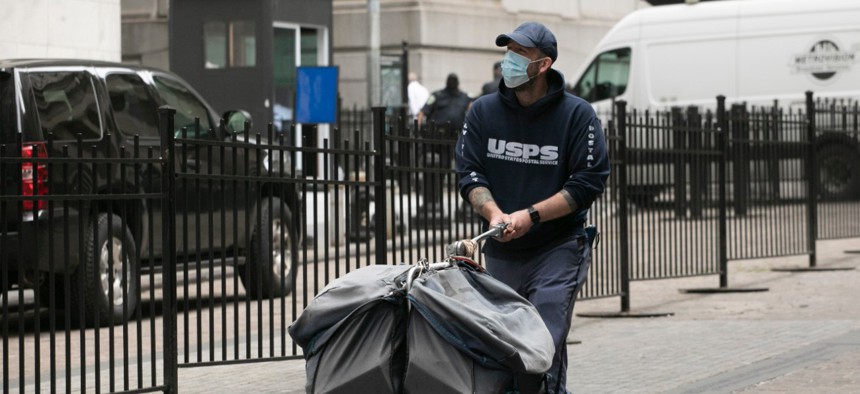
A masked postal worker pushes a cart of mail as he makes his rounds, Tuesday, May 26, 2020, in New York. Mark Lennihan/AP
Wonder How You’re Going to Go Back to Work? Watch the Postal Service
Having helped many of us stay safe at home during the pandemic, USPS is establishing the protocols we may need to return to work and school.
“Neither snow nor rain nor heat nor gloom of night stays these couriers from the swift completion of their appointed rounds.” – The United States Postal Service Creed
In addition to snow, rain, heat and the gloom of night, we can now add COVID-19 to the list of hurdles postal workers routinely overcome to deliver the mail.
As the United States begins to reopen on a state by state basis, there’s one large workforce that has been having a very different pandemic experience from most: federal employees. Unlike some private, non-profit and local government sectors, federal employees have largely continued to work during the pandemic, many of them teleworking. Postal Service employees, in particular, have been critical to keeping commerce flowing, allowing millions of their fellow citizens to shelter in place.
Unfortunately, while keeping people supplied with critical goods and making it possible for entire regions of the country to shelter in place, USPS employees have been placed at higher risk as they continue to report for duty at postal facilities, handle mail and packages potentially contaminated with the coronavirus, and interact with the public, including those who may be infected. Postal work is often difficult and thankless, and it has been exponentially more dangerous since much of the nation went into lockdown in March 2020.
Having helped many of us stay safe at home during the pandemic, the Postal Service may now be leading the way in terms of setting the protocols that will need to be in place when, eventually, everyone else returns to work and school. As Government Executive reported last month, the Postal Service will begin testing a temperature screening protocol at facilities in Virginia and Oklahoma which will check employee temperatures on a daily basis with the goal of screening for those who may be infected with the novel coronavirus, so they can immediately quarantine and avoid placing others at risk. Screening for fevers has become an interesting tool of public health analysis, as shown by the data collected by one smart home thermometer company which has developed and published a strikingly accurate healthweather.us tool that predicts coronavirus hotspots based on “atypical fevers” detected by the devices it has sold to consumers for home use.
While the USPS’s initial screening will apparently be voluntary only, temperature screenings may become a new standard by which the rest of the workforce will be checked regularly to ensure individuals are safe to attend work and school as the pandemic continues. In this way, Postal employees will not only have kept us fed and clothed while we were sheltering in place, but also led the way as we emerge from our homes when the conditions are right.
Heather White is a partner in the Federal Practice Group, where she specializes in federal sector employment litigation.






